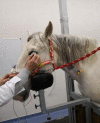Comparison of two sedation protocols for long electroretinography in horses using the Koijman electrode
- PMID: 37537621
- PMCID: PMC10401785
- DOI: 10.1186/s12917-023-03654-9
Comparison of two sedation protocols for long electroretinography in horses using the Koijman electrode
Abstract
Background: In modern times, horses are utilized not only for labour and transportation purposes but also for recreational activities such as competition and pleasure riding. In these various pursuits, the role of vision plays a crucial role. Electroretinography is the most used test to diagnose diseases of the retinal outer segment. There is a wide variety of devices to perform the electroretinography differing one from each other in the corneal electrode and the light stimulation. The Koijman electrode has been tested in dogs but not in horses. The main purpose of this study was to compare electroretinography parameters from horses sedated with detomidine alone or in combination with butorphanol, during a standardized protocol using the Koijman electrode and RETI-port® system. Seven mares were allocated to the detomidine and detomidine plus butorphanol group in a randomised, controlled, crossover study. Friedman and Willcoxon-signed ranked tests were used to compare the electroretinogram parameters. A Student's t-test was used to compare differences in the number of artefacts to valid values ratio obtained under both sedation protocols.
Results: Dark adaptation peaked after 16 min under scotopic conditions in both groups. No significant differences in electroretinogram parameters between groups were observed. During the mixed rod and cone response evaluation under scotopic conditions, all mares made a movement of the head resulting in a high number of artefacts. The detomidine plus butorphanol group showed a non-significant tendency to have fewer artefacts and a longer duration of sedation compared to the detomidine group.
Conclusions: Detomidine alone or combined with butorphanol may be suitable to use Koijman electrode and the RETI-port® to perform a standardized long protocol in horses with some adaptations.
Keywords: Butorphanol; Detomidine; Horse; Koijman electrode; Long electroretinography.
© 2023. BioMed Central Ltd., part of Springer Nature.
Conflict of interest statement
The authors declare no competing interests.
Figures






References
-
- Ben-Shlomo G, Plummer C, Barrie K, Brooks D. Characterization of the normal dark adaptation curve of the horse. Vet Ophthalmol. 2012 Jan;15(1):42–5. - PubMed
-
- Ekesten B, Komáromy AM, Ofri R, Petersen-Jones SM, Narfström K. Guidelines for clinical electroretinography in the dog: 2012 update. Doc Ophthalmol. 2013 Oct;127(2):79–87. - PubMed
-
- Sandmeyer LS, Bellone RR, Archer S, Bauer BS, Nelson J, Forsyth G, et al. Congenital stationary night blindness is associated with the leopard complex in the miniature horse. Vet Ophthalmol. 2012 Jan;15(1):18–22. - PubMed
-
- Ben-Shlomo G. The equine Fundus. Vet Clin North am equine Pract. 2017 Dec;33(3):499–517. - PubMed
Publication types
MeSH terms
Substances
LinkOut - more resources
Full Text Sources

